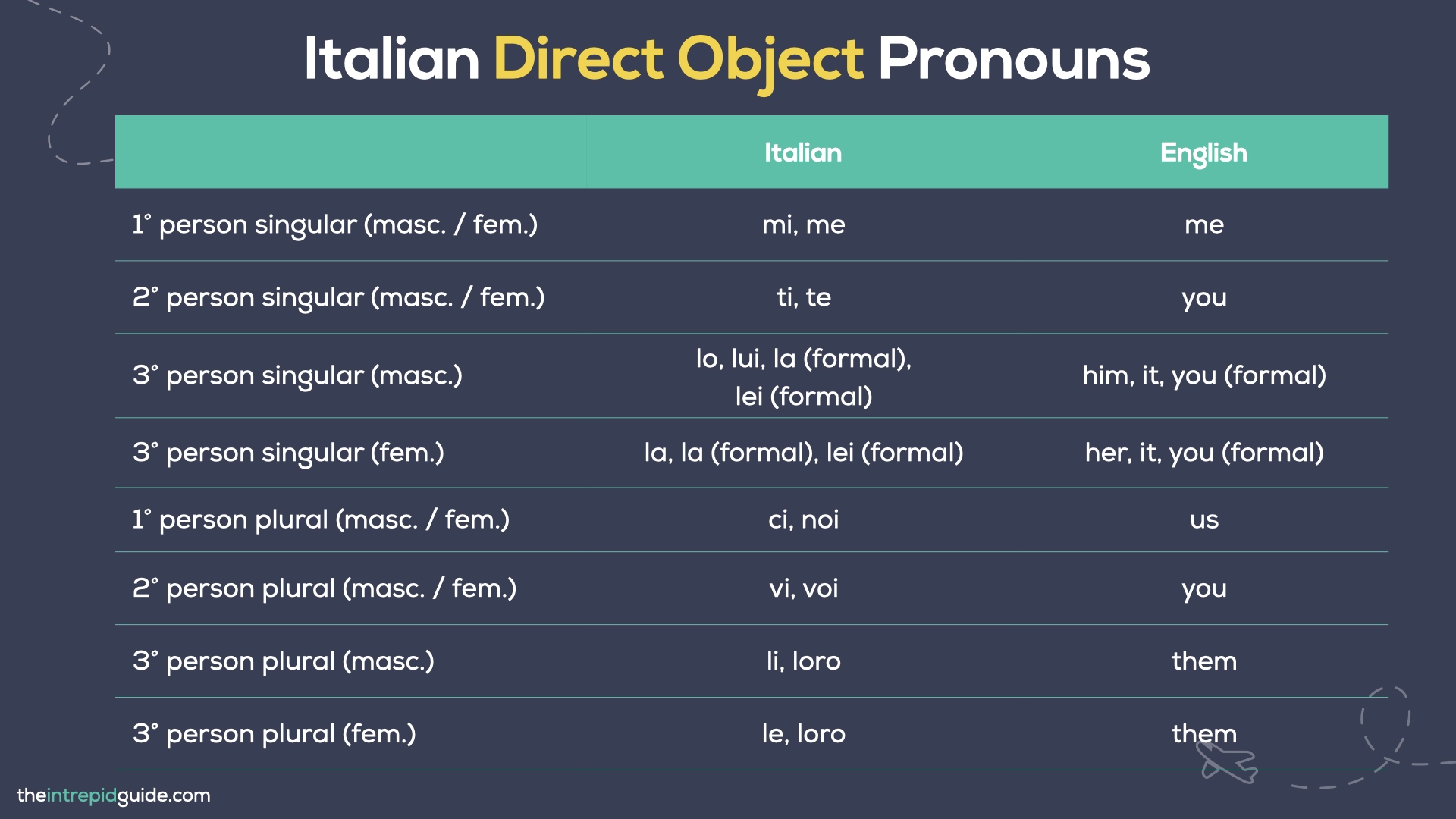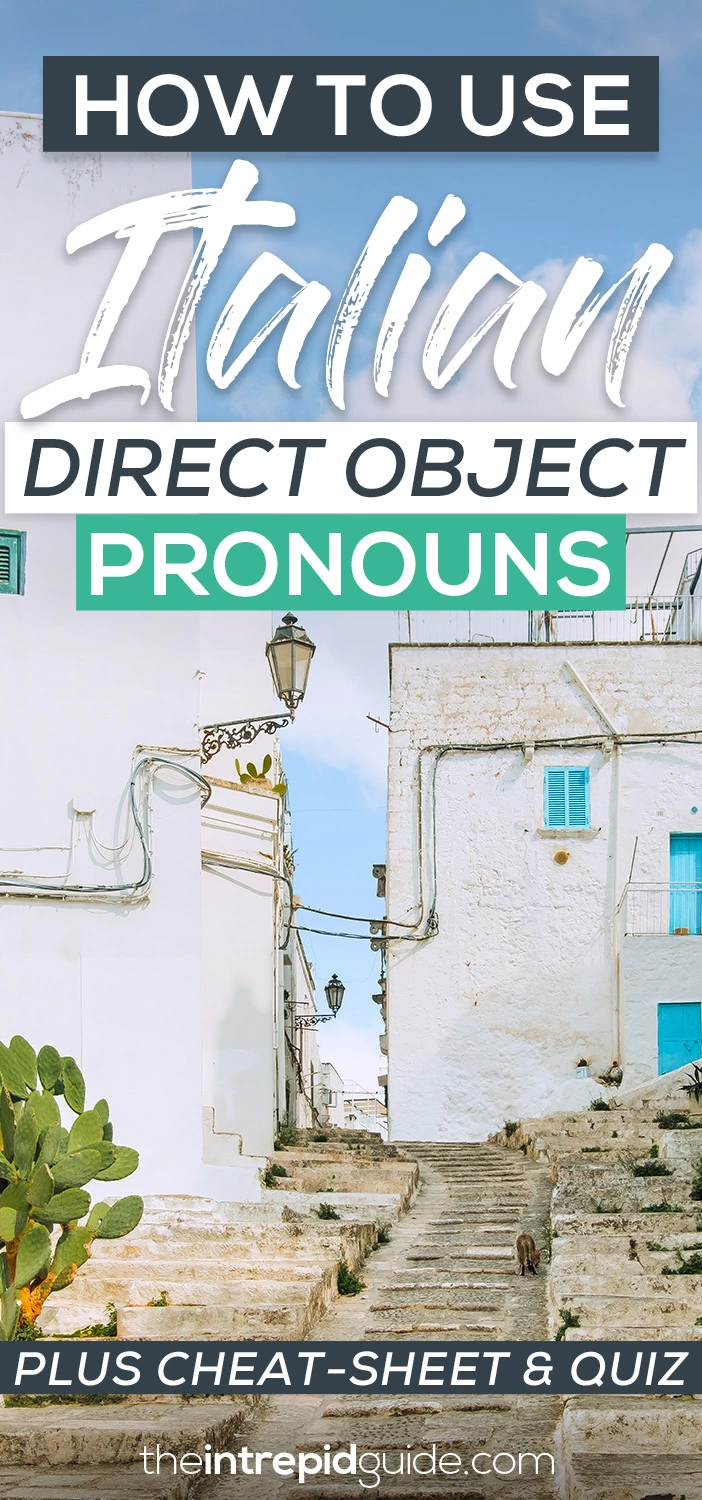Say you are at a quaint little shop in Rome, picking out souvenirs for your loved ones. You find a beautiful print of the Colosseum and ask the shopkeeper, Quanto costa? (How much is it?). Upon agreeing to the price, you can sound more like a local by saying La prendo (I’ll take it) instead of Prendo questa stampa (I’ll take this print). In this example, la is a direct object pronoun replacing questa stampa. Using this little word makes the phrase shorter and more natural.
This is the role of Italian direct object pronouns: they replace the direct object in a sentence, preventing repetitive language and smoothing the flow of conversation. They’re typically used to answer the questions ‘Who?’ or ‘What?’.
With the help of this guide, you’ll be able to confidently use direct object pronouns in Italian , adding an authentic flair to your conversations and bringing you one step closer to speaking like a true local. To see how much you’ve learned, don’t forget to complete the free quiz at the end of this lesson to test your new-found knowledge!
Before we get started, make sure you download your FREE PDF cheat-sheet for this lesson which includes a practical summary of everything you’ll learn in this guide. Just enter your email below and I’ll send it to you straight away.
By the way, want to improve your Italian quickly and hav fun doing it?
I thought so.
If you’re a beginner, I recommend Intrepid Italian, my comprehensive self-paced programme that teaches you through the power of my unique 80/20 method. The course covers everything you need to know as a beginner in Italian (including how to use pronouns). Join now for lifetime access and my 30-Day “Celebrate with a Spritz” money-back guarantee by clicking here.
Or if you’re already at the intermediate level, why not enrol in Intrepid Italian for Advanced Beginners (A2) or Intrepid Italian for Intermediates (B1), my more advanced programmes that helps you master the trickiest aspects of Italian grammar while as you edge closer to fluency in Italian.
When you start learning Italian, it’s pretty common to keep repeating the same basic phrases and words, but if you’re gunning for fluency, it’s time to shake things up a bit. The key? Familiarize yourself with Italian pronouns to inject rhythm into your sentences!
Cominciamo! (Let’s get started!)
Italian Direct Object Pronouns Chart
| Italian Direct Object Pronouns | |||
|---|---|---|---|
| Italian | English | ||
| unstressed (atonic) | stressed (tonic) | ||
| 1° person singular (masc. / fem.) | mi | me | me |
| 2° person singular (masc. / fem.) | ti | te | you |
| 3° person singular (masc.) | lo, la (formal) | lui, lei (formal) | him, it, you (formal) |
| 3° person singular (fem.) | la, la (formal) | lei, lei (formal) | her, it, you (formal) |
| 1° person plural (masc. / fem.) | ci | noi | us |
| 2° person plural (masc. / fem.) | vi | voi | you |
| 3° person plural (masc.) | li | loro | them |
| 3° person plural (fem.) | le | loro | them |
Italian direct object pronouns vary based on the gender (masculine or feminine) and number (singular or plural) of the noun they replace.
Like indirect object pronouns, they are categorized into two types: unstressed (atonic) and stressed (tonic). The atonic pronouns blend into the sentence with less emphasis, as in Pietro mi ama (Pietro loves me), where mi is a direct object pronoun.
On the other hand, tonic pronouns are used for emphasis, as in Pietro ama me (Pietro loves me), where me is stressed. In other words, of all the people Pietro could love, he loves me!
How to use Italian Direct Object Pronouns
Let’s explore these differences in more detail to better understand their usage.
Unstressed (atonic) direct object pronouns in Italian
What they are: Atonic direct object pronouns are the most frequently used in Italian. With them, the focus of the sentence is shifted towards the action (verb) rather than the object (pronoun).
Placement: before the conjugated verb.
Here are some examples:
- Luigi la chiama al telefono tutti i giorni (Luigi calls her on the phone every day).
- Li hanno chiamati per il rimborso (They called them for the refund).
- Amo molto i film. Mi piace guardarli al cinema (I love movies. I like to watch them at the cinema).
Exceptions in pronoun positioning:
With infinitive, gerund, and imperative forms, these pronouns follow the verb, forming a single word:
- Infinitive example: Non vedo l’ora di leggerlo (I can’t wait to read it).
- Gerund example: Guardandolo per la prima volta mi vennero i brividi! (Looking at it for the first time, I got shivers!)
- Imperative example: Mangiala! (Eat it!). In the imperative negative form, the direct object pronoun can be placed either before the infinitive verb or after it. Thus, both non guardarla and non la guardare can be used with the meaning “don’t look at her.”
Attenzione!: with the present perfect, the direct object pronouns lo and la shorten to l’ in front of the auxiliary verb avere (to have). For example:
- Anna ha chiamato Lucia (Anna called Lucia) —> Anna l’ha chiamata (Anna called her).
Also, with this tense, the ending of the past participle changes according to the gender and number of the direct object pronoun. For example:
- Ho comprato la borsa (I bought the bag) —> L’ho comprata (I bought it – feminine) or
- Ho comprato il libro (I bought the book) —> L’ho comprato (I bought it – masculine).
Stressed (tonic) direct object pronouns in Italian
What they are: used in sentences where the focus is on the pronoun itself, or when the pronoun stresses the identity of the person involved, often contrasting with someone else.
Placement: always follow the verb.
Here are some examples:
- Hanno scelto lei per quella parte nel musical, non me (They chose her for that part in the musical, not me).
- Ora andiamo a cercare un regalo per loro? (Now shall we go find a gift for them?)
- Io ho sempre amato te, non lui! (I have always loved you, not him!)
Attenzione: tonic direct object pronouns can often appeare after words such as anche (also), persino (even), eccetto (except):
- Anna e Sandro hanno invitato anche voi al matrimonio? (Did Anna and Sandro also invite you to the wedding?)
- Hanno partecipato tutti alla riunione tranne noi (Everyone attended the meeting except for us).
Italian Direct Object Pronouns Quiz
Let’s test your knowledge of Italian direct object pronouns. Fill in the blanks in these sentences using the correct direct object pronoun.
If you found this lesson powerful, then you’ll love Intrepid Italian, my series of online self-paced video courses that break down everything you need to know about Italian using my 80/20 method. Visit IntrepidItalian.com for more details.
 Are you a beginner or an intermediate Italian learner? Got a trip coming up or want to communicate with your Italian partner or relatives in Italian? Learn Italian with my unique 80/20 method
Are you a beginner or an intermediate Italian learner? Got a trip coming up or want to communicate with your Italian partner or relatives in Italian? Learn Italian with my unique 80/20 method
Registrations are now open to join Intrepid Italian, my new series of online video courses that use my unique 80/20 method. You’ll go from a shy, confused beginner to a proficient and confident intermediate speaker, with me as your trusty guide.
You’ll finally be able to connect with your Italian partner, speak to your relatives and enjoy authentic travel experiences in Italy that you’ve always dreamed of, and so much more.
As a native English speaker who learned Italian as an adult, I know what it’s like to feel hopeless and lack the confidence to speak. I know what it’s like to start from scratch and to even go back to absolute basics and learn what a verb is!
Intrepid Italian was created with YOU in mind. I use my working knowledge of the English language to help you get into the ‘Italian mindset’ so you can avoid the common pitfalls and errors English speakers make – because I made them once too! I break everything down in such a way that it ‘clicks’ and just makes sense.
No matter what your level is, there is an Intrepid Italian course for you, including:
- 🇮🇹 Intrepid Italian for Beginners (A1)
- 🇮🇹 Intrepid Italian for Advanced Beginners (A2)
- 🇮🇹 Intrepid Italian for Intermediates (B1)
You can join 1, 2, or all 3 courses, it’s entirely up to you. The best part is that you have lifetime access so you learn anytime, anywhere and on any device.
As your guide, I walk you through each lesson, step-by-step, using my unique 80/20 method. My approach is different from traditional methods because I teach you the most important 20% of the language right from the beginning so you can start to speak straight away.
Each course includes video lessons, audio exercises, downloadable worksheets, bonus guides, a private support community, and lifetime access all designed to streamline your learning while having fun.
It even comes with my famous “Celebrate with a Spritz Guarantee”. After 30 days of using Intrepid Italian, if you don’t want to celebrate your new-found Italian skills with an Aperol Spritz, you don’t have to pay a penny! Cheers! 🥂
Join Intrepid Italian here and start learning today!
Ci vediamo lì! (See you there!)
Learning Italian? Check out these Italian language guides
- Italian for Beginners | How to Learn Italian in 3 Simple Steps
- TOP 100 Most Common Italian Words (Plus PDF Cheat-Sheet & Quiz)
- Italian Prepositions:The Only Guide You’ll Ever Need (PLUS Chart)
- 17 Weird Italian Superstitions Italians ACTUALLY Live By
- 17 Must-Know Italian Hand Gestures: The Ultimate Guide
- 10 Ways Natives REALLY Say ‘You’re Welcome’ in Italian
- How to say ‘Please’ in Italian in 9 Ways Like a Native
- 41 Italian Greetings: How to Say ‘Hello’ in Italian Like a Local
- 125 Most Common Italian Phrases for Travel You’ll Ever Need [PLUS Printable]
- 8 DEADLY mistakes in Italian (& How to Avoid Them)
- How to Conjugate Italian Verbs in 3 Simple Steps [Italian for Beginners]
- Is Italian Hard to Learn? 7 Common Mistakes & How to Avoid Them
- Master Days of the Week in Italian (7 Simple Memory Hacks)
- Italian Numbers: How to Count in Italian From 0 to 1 Billion (Plus PDF Download)
- How to Order Food & Drinks in Italian [Italian for Beginners]
- 15 Italian Words You Should NEVER Mispronounce [& How Not To]
- 11 Effective Hacks That’ll Help You Learn Italian So Much Faster
- Top 14 Italian Words You Should NEVER Say [& What to Use Instead]
- 20 Hilarious Everyday Italian Expressions You Should Use
- Romanesco: 25 Cool Roman Dialect Words You Should Use in Rome
- 10 Reasons Why Learning Italian Will Change Your Life
- 10 Italian Expressions Italians Love Saying
- 10 Italian Phrases That Will Instantly Make You Sound more Italian
- Funny Italian Sayings: 26 Food-Related Insults You Won’t Forget
- 15 Romantic Italian Films That’ll Make You Love Italy Even More
- How to Master Common Italian Phrases for Travel (Like a Local!)
Like it? Pin it for later!
Over to you!
Did you enjoy this lesson? Do you have a question? Let me know using the comments section below or join me on social media @intrepidguide or @intrepiditalian to start a conversation.
Thanks for reading and I hope you enjoyed this post.
Like what you see? Subscribe using the form below to have all of my posts delivered directly to your email.




